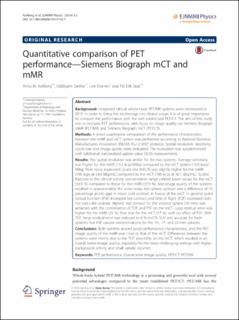| dc.contributor.author | Karlberg, Anna Maria | |
| dc.contributor.author | Sæther, Oddbjørn | |
| dc.contributor.author | Eikenes, Live | |
| dc.contributor.author | Goa, Pål Erik | |
| dc.date.accessioned | 2020-06-08T11:51:11Z | |
| dc.date.available | 2020-06-08T11:51:11Z | |
| dc.date.created | 2016-11-28T10:04:06Z | |
| dc.date.issued | 2016 | |
| dc.identifier.citation | EJNMMI Physics. 2016, 3:5 1-14. | en_US |
| dc.identifier.issn | 2197-7364 | |
| dc.identifier.uri | https://hdl.handle.net/11250/2657210 | |
| dc.description.abstract | Background: Integrated clinical whole-body PET/MR systems were introduced in2010. In order to bring this technology into clinical usage, it is of great importance to compare the performance with the well-established PET/CT. The aim of this study was to evaluate PET performance, with focus on image quality, on Siemens BiographmMR (PET/MR) and Siemens Biograph mCT (PET/CT).Methods: A direct quantitative comparison of the performance characteristics between the mMR and mCT system was performed according to National ElectricalManufacturers Association (NEMA) NU 2-2007 protocol. Spatial resolution, sensitivity,count rate and image quality were evaluated. The evaluation was supplementedwith additional standardized uptake value (SUV) measurements. Results: The spatial resolution was similar for the two systems. Average sensitivity was higher for the mMR (13.3 kcps/MBq) compared to the mCT system (10.0 kcps/MBq). Peak noise equivalent count rate (NECR) was slightly higher for the mMR(196 kcps @ 24.4 kBq/mL) compared to the mCT (186 kcps @ 30.1 kBq/mL). Scatterfractions in the clinical activity concentration range yielded lower values for the mCT(34.9 %) compared to those for the mMR (37.0 %). Best image quality of the systems resulted in approximately the same mean hot sphere contrast and a difference of 19 percentage points (pp) in mean cold contrast, in favour of the mCT. In general, point spread function (PSF) increased hot contrast and time of flight (TOF) increased both hot and cold contrast. Highest hot contrast for the smallest sphere (10 mm) was achieved with the combination of TOF and PSF on the mCT. Lung residual error was higher for the mMR (22 %) than that for the mCT (17 %), with no effect of PSF. With TOF, lung residual error was reduced to 8 % (mCT). SUV was accurate for both systems, but PSF caused overestimations for the 13-, 17- and 22-mm spheres. Conclusions: Both systems proved good performance characteristics, and the PETimage quality of the mMR was close to that of the mCT. Differences between the systems were mainly due to the TOF possibility on the mCT, which resulted in an overall better image quality, especially for the most challenging settings with higher background activity and small uptake volumes. | en_US |
| dc.language.iso | eng | en_US |
| dc.publisher | Springer Open | en_US |
| dc.rights | Navngivelse 4.0 Internasjonal | * |
| dc.rights.uri | http://creativecommons.org/licenses/by/4.0/deed.no | * |
| dc.title | Quantitative comparison of PET performance-Siemens Biograph mCT and mMR | en_US |
| dc.type | Peer reviewed | en_US |
| dc.type | Journal article | en_US |
| dc.description.version | publishedVersion | en_US |
| dc.source.pagenumber | 1-14 | en_US |
| dc.source.volume | 3:5 | en_US |
| dc.source.journal | EJNMMI Physics | en_US |
| dc.identifier.doi | 10.1186/s40658-016-0142-7 | |
| dc.identifier.cristin | 1404816 | |
| dc.description.localcode | © 2016 Karlberg et al.Open Access. This article is distributed under the terms of the Creative Commons Attribution 4.0 InternationalLicense (http://creativecommons.org/licenses/by/4.0/), which permits unrestricted use, distribution, and reproduction in any medium, provided you give appropriate credit to the original author(s) and the source, provide a link to the Creative Commons license, and indicate if changes were made. | en_US |
| cristin.ispublished | true | |
| cristin.fulltext | original | |
| cristin.qualitycode | 1 | |

